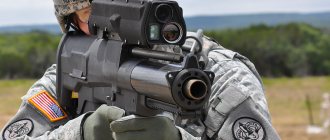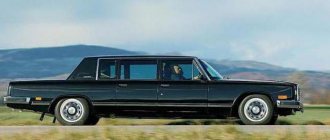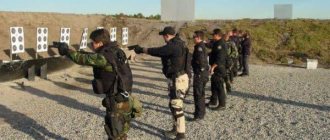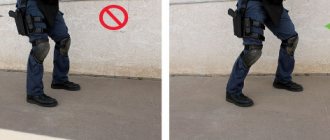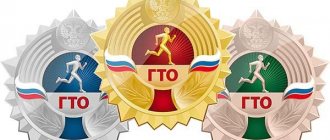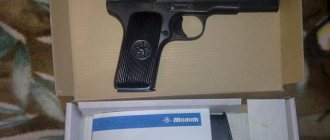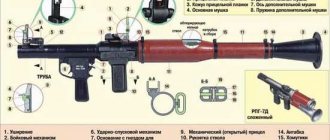Vladimir May 23, 2020 Category Life Safety
OBZH 4
Hello! Do you know why fire training is needed at five-day training camps with tenth grade students? Today I would like to talk more about what a 10th grade student should know about this discipline of academic fees.
First of all, I would like to note that any warrior should know his weapon: its weaknesses and strengths, the names of parts and mechanisms, and, if necessary, restore the functionality of his weapon.
Without this knowledge, allowing a fighter to use weapons is simply dangerous. This is why I believe that the importance of fire training at training camps is very difficult to overestimate. In principle, for the sake of performing the initial shooting exercise, many people decide to participate in training camps, although there is nothing so complicated about it.
The legendary AK-74M assault rifle is still in service with the modern army of the Russian Federation. Why legend? Everything is very simple: the AK-74M can be described in just three words - simple, reliable, trouble-free.
Tactical and technical characteristics of the AK-74M assault rifle
There is no point in dwelling on this topic for too long - you just need to remember the performance characteristics. What is it for? It's simple: to use a machine gun, for example, you need cartridges, but what kind? This will be one of the parameters of the machine’s performance characteristics.
The Kalashnikov design bureau assault rifle has quite competitive indicators - rate, firing range, target firing range, etc. This machine gun can additionally be equipped with a sighting device, a bayonet and an under-barrel grenade launcher. Agree that this is already a lot.
As for the main characteristics of the machine itself, they can be seen in the picture below.
Responsibilities and rights of participants
The shooter must not rely on additional objects or structures while firing. In this case, the rifle must be firmly fixed with both hands and rested on the shoulder; shooting from the hip is prohibited. Slings cannot be used on rifles.
Attention! Participants must strictly follow the instructions of coaches and judges . Refusal or violation will result in disqualification. The participant is responsible for any physical or material damage resulting from careless and thoughtless handling of equipment.
Maintenance of the AK-74M assault rifle
Do not be mistaken that if the machine is reliable and trouble-free, then nothing will happen to it. This is not entirely true. You need to take care of the machine gun - monitor its cleanliness, serviceability, and shooting performance. After each shooting, the AK-74M must be cleaned, like, in principle, any other type of weapon.
In order to clean the machine gun, you need to partially disassemble it and remove any remaining dust, carbon deposits and all derivatives of firing. You can read about the procedure for disassembling and assembling the machine in this article of mine.
Targets
For shooting, a classic target number 8 . , the same target is used for shooting from a distance of five and ten meters
Minesh number eight has a total size of eighty by eighty millimeters.
Reference. The diameter of the target itself is forty-five and a half millimeters . A black apple has a diameter of thirty and a half millimeters . Ten is about half a millimeter.
Safety rules when shooting from a Kalashnikov assault rifle
When firing from any weapon, you must strictly follow the safety rules:
- It is prohibited to perform any actions at the firing line without the command of the shooting director: loading weapons with live or blank cartridges, firing, transferring weapons to other people.
- Pointing a weapon at people, regardless of whether it is loaded or not.
- Disassemble and assemble weapons and ammunition.
- Open and fire from a weapon that is faulty.
- Touch unexploded grenades and shells.
This is only a partial list of safe shooting requirements. Usually, before each stage of shooting, the director conducts a full briefing, explaining the safety rules to the shooting participants.
What competitions are held
Air rifle shooting competitions have certain regulations and procedures.
Order of conduct
Competitions can be local, regional and international.
All competitions in this discipline must be held in specially equipped shooting ranges, shooting ranges, training grounds or in any other specialized premises.
Every month there is a new tournament. In general, the competition order includes the following stages:
- participants' application;
- qualifying round;
- conducting briefings;
- holding competitions in shooting from pneumatic weapons.
Important! The internal order of the competition may change at the discretion of the panel of judges or the organizing committee.
Goals and objectives
Competitions are held with the aim of popularizing the shooting sport in the Russian Federation among the younger and older generations, as well as to develop patriotism and strong-willed qualities among those participating. The expectation is that the participants will subsequently defend their homeland at a professional level.
The basis is the promotion of a healthy lifestyle, defense of the fatherland , as well as the formation of shooting skills and the will to win.
Basic Rules
Each participant has three test shots, the result of which is not included in the report card. Next, the shooter is given 5 shots , for which 10 minutes . The shooter also has three minutes of preparation before starting the test.
Photo 2. Air gun brand IZH-38. Similar weapons are used in shooting competitions.
Fire is carried out from pneumatic weapons of the VP (type IZH-38, IZH-60, MR-512, IZH-32, MR-532, MLG, DIANA ) while standing or sitting. The distance to the target depends on the rank of the participants. For the third degree, fire is fired from five meters, for the rest - from ten meters. The organizer provides weapons for performing the test.
Venues
For competitions, a shooting range or other site is used, which must meet the requirements of the competition. A shooting range or area includes the following elements:
- line of fire, as well as position for firing;
- a line or series of targets;
- a specially fenced area where participants prepare;
- a storage room where rifles, ammunition, medals or other items used in competitions are stored;
- area for the panel of judges.
The line of fire itself should be divided into two zones:
- The firing line itself, with positions for shooters, is up to one meter wide and one and a half meters deep.
- An area for coaching staff, competition leaders, and spectators. In this case, the territory must be separated by a barrier from the firing line.
Firing positions must be on the same plane . The front boundary of the firing line is indicated by a colored line on the floor (the width of this line is not included in the firing range).
Reference. No part of the shooter's body should have contact with the surface of the shooting range lying in front of the firing line.
In addition, the shooting positions are equipped with a stand with a stand on which an observation tube, a chair or stool for the participant, and a chair or stool for the judge are attached.
Other types of weapons and ammunition in the RF Armed Forces
Our army has many different types of personal small arms, all of them have their own characteristics that affect their use. Now I want to talk about pomegranates.
There are two types of grenades:
- Defensive
- Offensive
Their most important fundamental difference is the range of fragments, that is, the radius of destruction of the enemy. It is not difficult to assume that defensive grenades have a larger damage radius; this directly follows from the peculiarities of combat.
You can talk about fire training for a very long time - this topic is quite extensive and it is simply impossible to cover it in one article. However, if you are interested in additional information, then you can either try to find it yourself, or indicate in the comments what else you would like to know about this topic.
In conclusion, I would like to invite you to consolidate the knowledge you have acquired and take a fire training test. The test has various tasks - requiring only one answer, a task to establish the correct order of certain actions (you will need to move blocks of information, establishing a certain sequence) and matrix choice tasks - where one correct answer corresponds to one criterion.
And that’s all for today, subscribe to blog updates, share the article with friends on social networks and comment on blog posts. Next up is a section dedicated to the chemical and chemical safety industry. Until we meet again, bye-bye.
Shooting exercises
Within the framework of the “Ready for Labor and Defense” standard, namely in performing air rifle shooting when the target is located at a distance of five and ten meters, the following are provided:
- shooting while standing;
- prone shooting;
- shooting from the knee;
- shooting from a position similar to the location of the target.
It is recommended to start shooting at a white sheet of paper so as not to develop the bad habit of pulling the trigger.
Test on the section “Fire training”
Time limit: 0
Navigation (job numbers only)
0 out of 10 tasks completed
Questions:
- 1
- 2
- 3
- 4
- 5
- 6
- 7
- 8
- 9
- 10
Information
This test will allow you to assess the level of knowledge in fire training for young men in the 10th grade of secondary schools.
You have already taken the test before. You can't start it again.
The test is loading...
You must log in or register in order to begin the test.
You must complete the following tests to start this one:
results
Correct answers: 0 out of 10
Your time:
Time is over
You scored 0 out of 0 points (0)
Categories
- No category 0%
- 1
- 2
- 3
- 4
- 5
- 6
- 7
- 8
- 9
- 10
- With answer
- With a viewing mark
- Task 1 of 10
1.
Number of points: 1
Why is incomplete disassembly and assembly of a Kalashnikov assault rifle carried out? - Task 2 of 10
2.
Number of points: 1
What is the initial bullet speed (m/sec) of the AK-74M assault rifle? - Task 3 of 10
3.
Number of points: 1
From the proposed options for the names of the main parts and mechanisms of the machine, select one: - Task 4 of 10
4.
Number of points: 1
What caliber is the AK-74M assault rifle? - Task 5 of 10
5.
Number of points: 3
Specify the correct sequence of partial disassembly of the AK-74M:- Detach magazine
- Check the cartridge in the chamber of the machine gun, perform a control release
- Remove pencil case accessories
- Disconnect the cleaning rod
- Remove the muzzle brake compensator (if equipped)
- Remove the receiver cover
- Remove the return mechanism
- Remove the bolt carrier by separating the bolt from it
- Disconnect the gas pipe
- Task 6 of 10
6.
Number of points: 2
Determine the type of grenadeSorting Items
- F1
- RGD-5
Defensive Offensive
- Task 7 of 10
7.
Number of points: 1
A Kalashnikov assault rifle can fire: - Task 8 of 10
8.
Number of points: 1
When firing, cartridges are supplied from a box magazine with a capacity of - Task 9 of 10
9.
Number of points: 1
The firing range of the AK-74M assault rifle is: - Task 10 out of 10
10.
Number of points: 3
Sort the performance characteristics of the AK-74M assault rifle according to the following criteria:
The sniper is prepared to shoot on command or independently. During training sessions, the command to prepare to fire can be given separately, for example: “To the firing line, march at a pace” and then “Load.” If necessary, the firing position is indicated before the “Load” command.
Firing preparation includes taking the shooting position and loading the rifle. In addition, when taking the shooting position, the sniper removes the cover from the optical sight and places it in the bag for the optical sight and magazines, and also removes the rubber cap from the lens and places it on the battery housing; in inclement weather and when the sun's rays fall from the front, it moves the lens hood forward.
To assume a kneeling shooting position, take the rifle in your right hand by the barrel lining with the muzzle forward, at the same time put your right leg back, lower yourself onto your right knee and sit on your heel; The shin of the left leg should remain in a vertical position, and the hips should form an angle close to a right angle. Place the rifle with the barrel linings in your left hand, pointing it towards. side of the target.
To assume a sitting shooting position, take the rifle in your right hand by the barrel lining with the muzzle forward and at the same time, leaning on your left hand, sit on the ground half-turned in relation to the direction of the target, placing your heels firmly on the ground (Fig. a) or crossing your legs and tucking them under you so that the foot of one leg is passed between the thigh and shin of the other leg (Fig. b); place your left hand on the thigh of your left leg, as is more convenient, and grab the rifle by the barrel linings with this hand.
To assume a standing shooting position, turn half a turn to the right in relation to the direction of the target and, without placing your left leg, set it to the left approximately shoulder-width apart, as is more convenient for the sniper, while distributing the weight of the body evenly on both legs.
At the same time, moving your right hand slightly upward along the belt, remove the rifle from your shoulder and, grabbing it with your left hand from below by the barrel linings, vigorously push the muzzle forward towards the target.
To load a rifle you need:
— attach a loaded magazine to the rifle, if it was not previously attached to it;
- remove the rifle from the safety;
- pull the bolt frame back by the reloading handle until it stops and release it;
- put the rifle on safety if there is no immediate opening of fire or the “Fire” command is not followed.
2. Fitting, aiming and releasing the trigger. Development of standards: “Preparing for shooting from various positions (lying, kneeling, standing, from behind cover) when operating on foot”, “Unloading weapons when operating on foot”, “Preparing for shooting at night using a night sight when actions on foot" and "Unloading a weapon with a night sight while operating on foot."
2.1. Fitting, aiming and releasing the trigger.
To attach the rifle, remove the rifle from the safety (if it was on the safety); holding the rifle with your left hand by the barrel linings (Fig. a) or by the magazine (Fig. b), and with your right hand by the butt and, without losing sight of the target, rest the rifle with the butt against your shoulder so that you feel a tight fit of the entire butt plate to the shoulder ; tilting your head slightly forward and without straining your neck, place your right cheek against the cheek of the butt; Place the index finger of the right hand (first joint) on the trigger.
Elbows are installed as follows:
- when shooting prone, as well as from a trench from a prone position, place your elbows on the ground in the most comfortable position, approximately shoulder width apart.
To aim with an optical sight, keep your right eye near the eyecup along the optical axis of the sight, and you can close your left eye; by moving your elbows, and if necessary, your body and legs, bring the tip of the reticle square under the aiming point, while simultaneously pressing the trigger with the first joint of the index finger of your right hand. The lateral correction scale should be positioned horizontally, and the sniper should see the entire field of view of the sight.
If the sniper's eye is shifted to the side, up or down from the optical axis, a moon-shaped shadow will appear in the field of view of the sight in the direction where the eye is shifted. In the presence of moon-shaped shadows, bullets are deflected in the direction opposite to the shadow (see Aiming Errors).
When aiming with an open sight, close your left eye and look with your right eye through the slot of the sighting bar at the top of the front sight so that the front sight is in the middle of the slot of the sighting bar, and its top is level with the upper edges of the mane of the sighting bar, i.e. take an even front sight; bring an even front sight to the aiming point while simultaneously pressing the trigger.
When aiming, you need to ensure that the aiming bar is in a horizontal position.
To release the trigger, you must, holding your breath, continue to smoothly press the trigger until the trigger, unnoticed by the sniper, is released from the cocking position, i.e., until the shot is fired.
If, when aiming, the reticle square (flat front sight) deviates significantly from the aiming point or a moon-shaped shadow appears in the field of view, it is necessary, without weakening the pressure on the trigger, to clarify the aiming and increase the pressure on the trigger until the shot occurs.
When releasing the trigger, you should not attach importance to slight vibrations of the reticle square (flat front sight) at the aiming point.
The desire to press the trigger at the moment of best alignment of the reticle square (straight front sight) with the aiming point, as a rule, leads to tugging on the trigger and an inaccurate shot. If the sniper, pressing the trigger, feels that he can no longer breathe, then he must, without increasing or weakening the pressure on the trigger, resume breathing, then, again holding it while exhaling, clarify his aim and continue pressing the trigger .
2.2. Development of standards: “Preparing for shooting from various positions (lying, kneeling, standing, from behind cover) when operating on foot”, “Unloading weapons when operating on foot”, “Preparing for shooting at night using a night sight when actions on foot" and "Discharging a weapon with a night sight while operating on foot."
2.2.1. Features of working out standards for fire training.
Standards during classes and training are practiced using serviceable training (combat) machine guns (machine guns) and training cartridges.
The weapon must be fully equipped with accessories stored in their places.
Training to comply with standards related to disassembling and assembling weapons, equipping belts (magazines) is carried out only with training weapons and training ammunition at a separate training place. In exceptional cases, it is allowed to comply with the standards for disassembling and assembling weapons using combat weapons assigned to military personnel, subject to special rules for careful handling.
The standard is considered fulfilled if the conditions for its implementation are met during work and there have been no violations of safety requirements, as well as charters, manuals, instructions and manuals.
If, while working through the standard, the student makes at least one mistake that could lead to injury (defeat) to personnel, breakdown of weapons or an accident, fulfillment of the standard is stopped and the student is assessed as “unsatisfactory.”
For violation of the sequence of compliance with the standard, which did not lead to accidents, breakdown (damage) of weapons, as well as for each error leading to a violation of the conditions for fulfilling the standard, the requirements of charters, manuals, manuals, instructions, the score is reduced by one point.
When meeting standards in skin protective equipment (OZK, L-1, etc.), the time increases by 25%, and when working in respiratory protection equipment (gas mask, respirator) - by 10%.
At an air temperature of minus 10°C and below, plus 30°C and above, with heavy rain, snowfall, the time to comply with standards increases to 20%, and when operating at night, if the time for night conditions is not defined, it increases to 30%. .
Technical malfunctions of weapons discovered during the implementation of the standard are not eliminated (unless they interfere with the implementation of the standard). After completing the standard, the trainee reports on any defects identified.
The time for fulfilling the standard by a military personnel is counted by a stopwatch from the moment the command “To fulfill the standard - START” (or another established command) is given until the moment the standard is fulfilled and the trainee reports on its implementation.
2.2.2. The procedure for determining the assessment for meeting standards.
If a standard is practiced several times during the training process, then the grade for its implementation is determined based on the last result shown or on the result of a control attempt.
An individual rating for a serviceman for fulfilling several fire training standards is determined based on the marks received for fulfilling each standard.
3. Characteristics of moving targets. Lateral lead and methods for determining it.
When the target moves frontally (towards or away from the shooter), fire should be carried out with the sight set corresponding to the distance at which the target may be at the moment of opening fire, and taking into account corrections for air temperature and side wind. At a distance not exceeding the direct shot range, fire can be carried out with the sight installed corresponding to the direct shot range.
During flanking and oblique (oblique) movement of the target, fire with the sight installed, as indicated in Art. 141, and with the side handwheel set to a value corresponding to the lead and correction for the side wind. The distance that the target moves during the bullet's flight to it is called lead.
The lead is taken in the direction of the target's movement. So, when the target moves from left to right, move the middle point of impact to the right, and when the target moves from right to left, move it to the left. If shooting conditions do not allow you to take lead using the side handwheel (set the side handwheel to the desired division), then lead is taken using the lateral correction scale of the sight reticle or by moving the aiming point out in the target figures. When using the scale of lateral corrections of the sight reticle, aiming should be done by markings located in the direction from which the target is moving.
To determine the lead when firing at targets that have flanking movement (at right angles to the direction of fire), use the following table:
When the target moves at a speed different from that indicated in the table, the lead should be increased (decreased) in proportion to the change in the speed of the target.
When oblique (oblique) movement of the target, the lead determined for the flank movement of the target is reduced by half.
Move the aiming point away from the middle of the target. When making adjustments to the installation of the side handwheel, aim at the middle of the target. To make it easier to remember the leads in divisions of the side handwheel scale (sight reticle) for the flank movement of the target at a speed of 3 m/sec (10 km/h), the lead values can be rounded and it can be assumed that when shooting at a distance of up to 600 m, the lead is equal to 4.5 thousandths (scale divisions), and at long distances - 6 thousandths (scale divisions).
Fire at a target that has flanking and frontal movement is carried out by tracking the target or by waiting for the target (fire attack).
When firing by tracking a target, the sniper continuously moves the rifle in the direction of the target's movement and fires a shot at the moment of the most correct aiming.
When firing by waiting for the target (fire attack), the sniper takes aim at a point (local object) selected in front of the target, and as the target approaches this point, fires a shot (taking into account the lead by installing the side handwheel). If the target is unhit, then the sniper selects a new point on the target’s path, aims at it, and when the target approaches, fires the next shot. Firing in this manner continues until the target is hit.
If the lead is taken by moving the aiming point, the shot must be fired at the moment when the target approaches the intended point by the amount of the calculated lead.
The use of cartridges with tracer bullets when shooting at moving targets provides better observation of the results of shooting and the ability to clarify the amount of lead.
Shooting at enemy personnel on armored personnel carriers, cars and motorcycles should be carried out with cartridges with ordinary and armor-piercing incendiary bullets (at a ratio of 1: 1 or at a different ratio depending on the availability of cartridges with the specified bullets).
Determining the value of holes
Points are assigned to participants depending on which zone the hit was scored in.
Hitting the center, the so-called ten, gives ten points . Nine means nine and so on. Getting into the white zone is called milk, which gives zero points.
The points of 20 completed shots are summed up. This amount determines the participant’s result.
If several athletes score the same number of points, the points scored by each participant, the number of tens, nines and other zones knocked out .
The one who has the most knocked out zones is considered the winner. If such a calculation again leads to equality of results, the referee announces additional shootouts.
Important! If the shooter never hits the target, he gets zero points. If the shooter hits the same target several times, then the worst result of the hit is counted.
